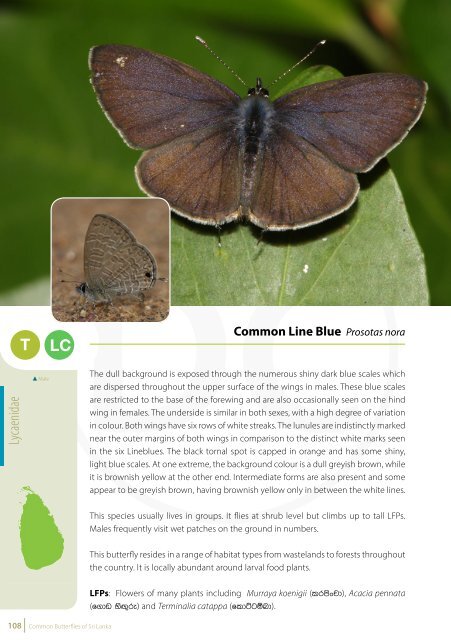Common Butterflies of Sri Lanka
Common Butterflies of Sri Lanka
Common Butterflies of Sri Lanka
You also want an ePaper? Increase the reach of your titles
YUMPU automatically turns print PDFs into web optimized ePapers that Google loves.
T<br />
LC<br />
<strong>Common</strong> Line Blue Prosotas nora<br />
Tailless Line Blue Prosotas dubiosa<br />
T<br />
LC<br />
Lycaenidae<br />
Male<br />
The dull background is exposed through the numerous shiny dark blue scales which<br />
are dispersed throughout the upper surface <strong>of</strong> the wings in males. These blue scales<br />
are restricted to the base <strong>of</strong> the forewing and are also occasionally seen on the hind<br />
wing in females. The underside is similar in both sexes, with a high degree <strong>of</strong> variation<br />
in colour. Both wings have six rows <strong>of</strong> white streaks. The lunules are indistinctly marked<br />
near the outer margins <strong>of</strong> both wings in comparison to the distinct white marks seen<br />
in the six Lineblues. The black tornal spot is capped in orange and has some shiny,<br />
light blue scales. At one extreme, the background colour is a dull greyish brown, while<br />
it is brownish yellow at the other end. Intermediate forms are also present and some<br />
appear to be greyish brown, having brownish yellow only in between the white lines.<br />
It has no tails and its wings are more rounded. The upper side <strong>of</strong> the male is a slightly<br />
different shade <strong>of</strong> blue in comparison to the <strong>Common</strong> Line Blue. In females, the blue<br />
is confined to the base <strong>of</strong> the forewing. While the underside <strong>of</strong> both sexes are similar,<br />
there is some varition in colour and more in pattern. Both wings have six bands <strong>of</strong><br />
irregular white lines, especially in the outer pair <strong>of</strong> bands <strong>of</strong> the forewing. The pair<br />
<strong>of</strong> basal bands <strong>of</strong> the forewing extends below the cell. The bands on the hind wing<br />
are not distinctly separated. Usually, the cresecent-shaped markings are more distinct<br />
than in the <strong>Common</strong> Line Blue, but never as in the Six Line Blues. The black tornal<br />
spot is outlined in orange at length, sometimes to the point <strong>of</strong> a complete ring. The<br />
anal angle could have two minute black spots surrounded by orange and blue scales.<br />
Lycaenidae<br />
This species usually lives in groups. It flies at shrub level but climbs up to tall LFPs.<br />
Males frequently visit wet patches on the ground in numbers.<br />
Its habits are almost similar to those <strong>of</strong> the <strong>Common</strong> Line Blue and both species tend<br />
to occur together.<br />
This butterfly resides in a range <strong>of</strong> habitat types from wastelands to forests throughout<br />
the country. It is locally abundant around larval food plants.<br />
Its habitats are also similar to that <strong>of</strong> the <strong>Common</strong> Line Blue, except that they are less<br />
likely to be found in wastelands. This butterfly is distributed throughout the country.<br />
LFPs: Flowers <strong>of</strong> many plants including Murraya koenigii (lrmsxpd), Acacia pennata<br />
(f.dv ysÕ=re) and Terminalia catappa (fldÜgïnd).<br />
LFPs: Flowers <strong>of</strong> Albizia odoratissima (iQßh udr), Pithecellobium dulce (ueks,d ishU,d)<br />
and Samanea saman (mdfr udr).<br />
108 <strong>Common</strong> <strong>Butterflies</strong> <strong>of</strong> <strong>Sri</strong> <strong>Lanka</strong><br />
<strong>Common</strong> <strong>Butterflies</strong> <strong>of</strong> <strong>Sri</strong> <strong>Lanka</strong> 109















